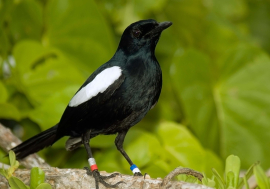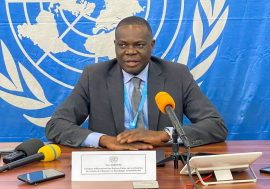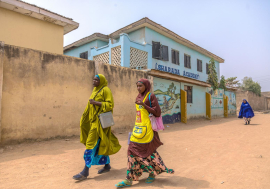Africa Wired
The country that gave the world two groundbreaking innovations in technology: M-Pesa, a mobile banking system, and Ushahidi, a platform for crowdsourcing information during disasters, is now taking its technological talents to new heights. The East African nation of Kenya has just started construction on a 5,000-acres piece of land in Konza, about 60km south of Nairobi, to turn the savannah area into “the most modern city in Africa”.
Using the same company that designed Brooklyn’s Barclays Center in New York City, SHoP Architects, Kenyan authorities want to transform Nairobi’s Konza City into Africa’s technology hub, dubbed Silicon Savannah, similar to California’s Silicon Valley. The designers told the UK’s Financial Times that “the scale of the project compares with creating another Manhattan, central London or inner-city Beijing.”
The Konza techno city project is the brainchild of Bitange Ndemo, Kenya’s permanent secretary in the ministry of information and communications. “Rather than echo a smattering of tech parks and business centres starting up on the continent,” says the Financial Times, “Kenya envisions a broader city-from-scratch to bring research universities, industry and government together, along the lines of Silicon Valley”.
The Wired magazine reported that Konza’s development “plan is extremely ambitious” and is “not just seen as a way of attracting investment from international tech companies and inspiring domestic entrepreneurs, but also as a way of reducing the corruption that has been endemic in the nation for several decades.”
Konza is expected to cement Kenya’s role as a regional technology leader in Africa. With a well developed technology sector, Kenya became the first country in Africa to open its government to the public by making millions of pages of internal governments documents available online. The country’s M-Pesa cell phone banking service is now being used all over the world for purchases and money transfers, and according to the US Time magazine, Ushahidi has been used “in 128 countries to map everything from [the 2010] earthquake in Haiti to [the] Japanese tsunami and the Arab Spring.”
The unveiling of the Konza project is being seen as a natural progression of Kenya’s aspirations to attract corporate investments in technology. In 2012, IBM set up its first African research lab in Nairobi, joining renowned American companies like Google, Microsoft and Intel that have their regional headquarters Kenya. Konza is heavily-influenced by similar “new cities”, like Cyberjaya in Malaysia, Cyber City in Mauritius and Egypt’s Smart Village, says the Wired.
The project is expected to cost $10 billion and create more than 200,000 jobs when completed in 2030. There are plans for an electronic manufacturing plant, an international financial centre and a convention centre. The government is offering tax breaks to companies as an incentive to move and invest in Konza.
Amid the euphoria and excitement over the prospects for Silicon Savannah, there have been some voices of caution. Technology experts at the Mobile Web East Africa conference held in Nairobi in February warned Kenya’s technology industry against copying the Silicon Valley business model. Their concern was that most of the companies being formed in Kenya were based on a single app or software programme.
“Kenya should be more of a ‘Digital Savannah’ and not ‘Silicon Savannah’, says TMS “Teddy” Ruge, co-founder of Project Diaspora USA/Uganda, an organization that mobilizes resources from Africans in diaspora to invest in Africa, “We are yet to manufacture things here, and most of the companies we have here are based on digital solutions.”
Kenya’s reputation as a technology leader in Africa suffered an embarrassing setback during the March national elections when both a biometric ID system designed to avoid multiple voting and an electronic transmission system to speed up vote counting broke down. The country’s independent electoral body was forced to switch to counting votes manually, slowing down the process and causing national anxiety.
Notwithstanding, Konza appears to be proving skeptics wrong. So far, more than a dozen companies are expected to start setting up operations in Konza.
“Konza will become a game-changer in Kenya’s socio-economic development, spurring massive trade and investment across the entire region,” said President Mwai Kibaki at the groundbreaking ceremony held in January at the proposed new city.
Africa unveils its first smartphone and tablet
By Aissata Haidara
Excitement greeted news that Vérone Mankou, the 26-year old entrepreneur from the Republic of Congo, has designed Africa’s first smartphone and a tablet, the hand-held computer that comes with a touch screen.
Mankou’s tech company, VMK, designed the sleek smartphone and tablet, which was originally conceived in 2006 as an affordable computer to give Africans access to Internet. The devices run on Google’s Android software and are assembled in China, making some technology analysts question Mr. Mankou’s assertion that these were the first African touchpad tablet and smartphone. In response to such criticism, Mr. Mankou writes on his website, “We are somewhat offended by the disregard of those who persist in denying the authentication of our products, despite evidence.”
To reinforce the Made-in-Africa claim, Mr. Mankou named his smartphone Elikia, for “hope” in Congolese Lingala dialect. The official name for the tablet is Way-C, and it comes with wireless internet connectivity and four gigabytes of internal storage. Elikia has rear and forward-facing cameras and a 3.5in (8.9cm) screen, 512MB of RAM, and a 650MHz processor. Mr. Mankou plans to sell the devices across African countries as well as in Belgium, France and India.
VMK’s smartphone will have to compete against established brands such as Blackberry and Nokia, while the tablet has to face Apple’s iPad, Samsung Galaxy and others. About his smartphone, Mr. Mankou says, “We wanted to place on the market a quality smartphone with the same capacities as the others, while ensuring that it’s a product which is accessible to all.”
Mr. Mankou hopes to rely on pan-African sentiments. There appears to be an increasing desire among some in Africa to support homegrown products. Recently, for instance, there was a minor incident with app purchasing when Google Play did not accept credit cards issued in the Congo. VMK announced its own app store with apps “developed by Africans for Africa” and prepaid gift cards to give Africans a similar experience.
Several technology bloggers in Africa believe VMK’s devices, which are currently available through telecom carrier Airtel with the possible addition of MTN and Warid, could still expand their reach and compete on the international market. The Congolese entrepreneur has set big ambitions for his devices, “Apple is huge in the US, Samsung is huge in Asia, and we want VMK to be huge in Africa,” he says.
Livestock tracking in Africa goes high tech
By Pavithra Rao
In an era of lightning speed, ever-present wireless connectivity, high tech is now also being used to benefit livestock farmers in rural areas of Africa. Widely known for being used to track wild animals, GPS, or “Global Positioning System” tracking devices are being adapted by some small- and large-scale farmers to manage their livestock, notably in Kenya, Botswana, and South Africa.
Tracking an animal is accomplished through either the bolus technique, in which an animal is made to swallow a tracking “tablet”, or through a microchip implantation or an ear-tagging technique. Once fitted with a device, GPS technology can precisely pinpoint an animal’s location and alert farmers whenever the livestock goes missing or is stolen.
In addition, the technology is being fine-tuned to give farmers the ability to control outbreaks of diseases. Explaining how the GPS system works on animals, Ebby Nanzala of the New Agriculturalist, an online magazine that focuses on tropical agriculture, says, “Through their unique numbers on the tag, they [farmers] are able to maintain the data. If there is a disease outbreak, it will be easier for it to be tracked and controlled.”
Mr. Nanzala adds that though the costs for such technology are high, the cost of losing animals to theft and disease is clearly higher. While allaying fears of the high cost of technology, he notes that with government support, “the [GPS tracking] chips will be very cheap and could be used and re-used for over 30 years”.
Similarly, the UN Food and Agricultural Organization has created a GPS-based mobile phone application that will inform farmers of their animals’ vaccination schedules, veterinary treatments as well as disease outbreaks.




















